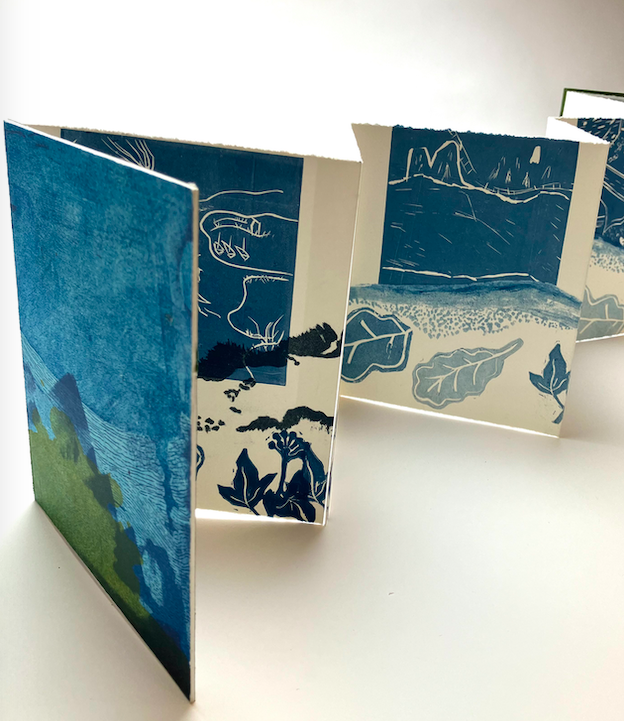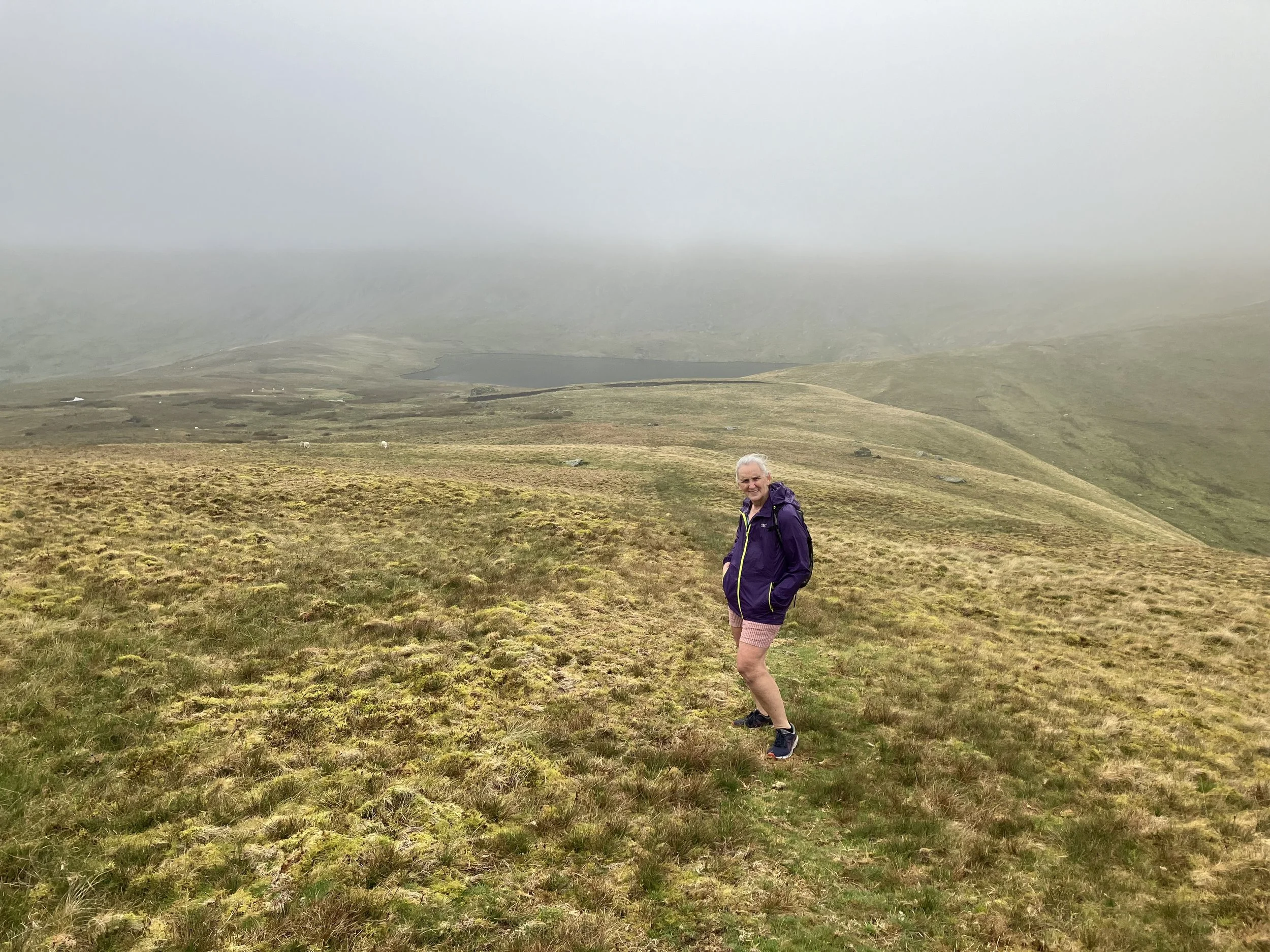

Artists Preswy / Tir Canol Residency
Residencies have been a big part of my arts practice - so much so that I established Stiwdio Maelor in Corris in 2014. In October 2024, I was standing in my studio (a print studio with three presses), thinking I would like to do a residency, as, for the last five years, I haven’t done as many residencies. But I looked around my studio and thought, ‘why do I need to go anywhere? I have everything here that I need. What I need is a residency at Maelor’.
The next day, I saw a message in a WhatsApp group, promoting the Tir Canol residency. It was like I had sent a wish out and it had been fulfilled. The residency was a perfect one for me – it provided me with an opportunity to not only work in my own studio but also to view the whole of the Dyfi valley as my studio, my source of inspiration and to be supported during this exploration.
My residency consisted of walking parts of the Dyfi river. The highlights were finding and exploring the source of the river and where the river ends at the river mouth. I walked established trails and found my own trails, foraging for moss and reeds to create sculptural baskets and capturing images to create into prints, each work reflecting my response to the sections of the river that I explored.
As part of the residency, I hosted two workshops; Exploring Dyfi: Chat and Carve, one with Bro Gerddi in Machynlleth and one at Stiwdio Maelor. The workshops provided an opportunity to do a bit of carving and chat about living in the Dyfi Valley with community members. From the lino blocks and my lithographs, I created three concertina books. These concertina books are presented to Tir Canol as a record of my residency and interaction with the community.
I hosted an installation of my work in progress at Stiwdio Maelor as part of an exhibition to celebrate the beginning of advent. It provided an opportunity to discuss the work and hear other people’s stories of their thoughts and memories of the Dyfi Valley and the river.
Finishing the residency with an open day at Star of the Sea at Borth provided me with an opportunity to show my finished work, collaborate and interact with the other two artists and to discuss my work with people who came to the open day.
Following her visit to Creiglyn, Veronica Calarco channels inspiration into a short story.
Dod o hyd i’r afon
Dychmygu: meddwl heb sail
I imagined the river before I followed it.
A ribbon-like flow of water meandering through the landscape; flowing by on one side, green fields rising on the other.
I saw myself walking it, crossing over the confluence of the creek and the river, making my way through copses of gnarly trees, stepping over roots of river plants, squishing through muddy puddles, feeling reeds brush against my legs, foraging materials suitable for making.
I imagined moments of quiet.
Where the river slowed or found itself snared in amongst large and coarse woody debris, becoming stagnant, but alive with tiny insects, swimming amongst the detritus, buzzing above the murky water.
I imagined being deafened by the water, as the river uses brute force to carve channels through the earth, rushing to the sea to spread itself out on the sands before joining the ocean.
I imagined walks in sun dappled light, plants, stones and fences glistening with the morning dew.
Leaves turning from green to brown as the seasons changed. The ground becoming muddy with the winter rains.
I did not imagine what would be created from my explorations.
Map: darlun o wyneb y Ddaear sy’n dangos ffurf gwledydd, lleoliad trefi, uchder y tir, cyfeiriad afonydd, ffyrdd, ac ati.
Imagining the river was very different from experiencing the river. First, the finding of the river itself. I searched through maps that showed the river meandering over the land, tributaries, creeks, rivulets running all over the image. Thick blue lines, thin blue lines, contour lines, rivers passing other rivers but never connecting. Some maps focused on the river itself, others on the farms, roads and towns. Maps divided by human ownership, showing fence lines, houses, and buildings. I discovered an old book, Guide to the Dyfi Valley Way, guiding the way through both sides of the valley, illustrated with simple strip maps and little descriptions of each stage. Another map showed an illustrated picture condensing the whole river into a single blue illustration weaving its way through layers of green valleys. Another map, a thick blue line drawn on a red background, with coloured circles for each name of a town along the river.
But which map would be the one to guide me along the river?
And where to start?
At the source?
Or at the river mouth?
Tarddiad: y man y mae rhywbeth yn deillio ohono, e.e. ffynhonnell ffrwd o ddŵr
I am not a map reader. I don’t collect maps and pour over them. I don’t read the contour lines that will tell the lay of the land.
I began to imagine the headwaters. Searching through the Guide, to see if its guided walk passed near the source. The section over the Aran mountains seemed to be near. I could walk from Dinas Mawddwy to Llanwchllyn across the Aran mountains and take a small side trip to the lake. I started planning the ‘six hour’ hike, working out the logistics to find the best weather day, the bus route to Dinas Mawddwy and back home from Llanwchllyn.
I imagine the walk, the terrain, making the walk into a story before I had done it.
Mary read the maps and spoke of the terrain, the height of the contour lines.
After an early morning bus journey to Dinas Mawddwy, Mary and I find ourselves walking along a bitumen road and crossing rivers before eventually crossing a style. We pass through a gate and begin the steep, steep climb uphill. The trail winds its way through valleys along the top of the mountains, Aran Fawddwy, Erw Y Ddafaf-Ddu, Aran Benllyn, Pen-aran. The sun shines …
I have chosen the day wisely.
The first glimpse of the source, Creiglyn, a small freshwater lake, is from a cairn, on the eastern ridge of Aran Fawddwy. The short walk I imagined is instead a long descent down a steep side of the mountain, slanting down to the lake. Creiglyn, from the cairn, is beautiful to behold, a solid steel grey body lying under the rays of the sun, surrounded by the steep slopes of the Aran.
Mary tells me there are places to scramble down further on, but I realise the six-hour walk had become a nine-hour walk and there is still a distance to Llanwchllyn.
It would be wise to save the llyn for another day.
Ywen: anfarwoldeb, tragwyddoldeb, ac amddiffyniad
Another day arrived … mae’r haul yn gwenu again.
Jackie is here to provide a witches’ blessing on my arrival at the source.
Jackie, Mary and I pass through the gates of Saint Tydecho Church at Llanmaddwy. Jackie transposes yew for you when she writes. She speaks of the historical importance of the churchyard yew trees, how many there would have once been planted around this church, some predating the church. She imagines what the ywen have seen, the stories they could tell us of past events and lives. She walks around the large circumference of the ancient tree, every step meaningful in her communication with the tree.
Jackie looks inside its huge cavern and gathers small symbolic objects for later incantations at the source. As the sun continues to smile, we begin the hike that we hope will take us to the tarddiad.
This time after more research and consulting, I had found maps created by others who had completed the hike to Creighlyn. We pass through a green valley, at times following the river as we slowly wind our way uphill. Before we leave the established path, we stop for a break and Jackie teaches me to make cordage from Polytrichum Commune (common hair cap moss), which I later make into several coil baskets. Meandering up the valley, we leave the path at the base of a steep hill. Jackie and I pull ourselves up grabbing the fence with each step as a mist descends. We lose Mary, who has scrambled ahead. At the top we wander, lost, calling for Mary. I want to head down towards where I think the river is. Jackie wants to head straight ahead, following another fence.
As we debate and call out to Mary, a figure emerges from the grey, damp air, rucksack heavy on his back, walking stick swinging.
Offering us lollies he points us towards the fence; Mary emerges from the mist. Following the fence we descend towards Creiglyn, limited visibility only allows us to see the fence and the ground in front of us. As we reach the edge of a cliff, the mist lifts, and we see the lake shining in the sunshine. We run the last few meters, stumbling over the tufts of grass. We reach the edge of the lake, staring up at Aran Faddwy loaming over us. The sun shines brightly, the last of the mist dissipates. I see the mouth of the lake on the left-hand side. We cross through the muddy ground to the start of Afon Dyfi.
Instead of the river I imagined, a tiny stream flows from the lake, steel grey and frothy, bubbling over the rocks between high grasses. Jackie puts the objects she has collected into a bramble basket and releases it into the stream, chanting an inaudible incantation. We run beside the stream until the basket catches, tips and disappears.
We begin the long trek back to the car, foraging grasses and moss, high on reaching the lake.
Afon: ffrwd gref o ddŵr yn llifo i’r môr






